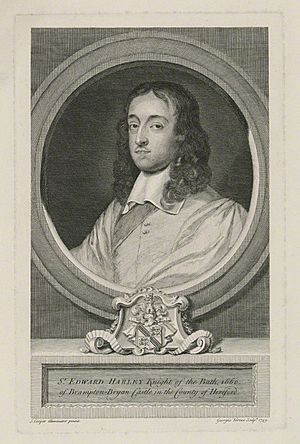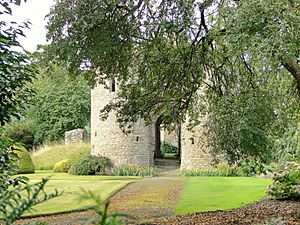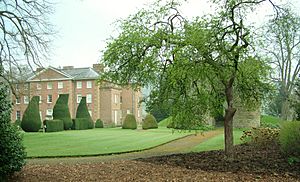Edward Harley (Parliamentarian) facts for kids
Quick facts for kids
Sir
Edward Harley
|
|
|---|---|

Sir Edward Harley, 1749 engraving
|
|
| Deputy lieutenant of Herefordshire and Radnorshire | |
| In office 1689–1700 |
|
| Member of Parliament for Herefordshire |
|
| In office October 1679 to April 1689 – February 1693 to September 1695 |
|
| Member of Parliament for New Radnor Boroughs |
|
| In office April 1661 – May 1679 |
|
| Deputy lieutenant of Herefordshire | |
| In office August 1660 – 1682 |
|
| Governor of Dunkirk | |
| In office May 1660 – May 1661 |
|
| Custos Rotulorum of Radnorshire | |
| In office 1660–1682 |
|
| Member of Parliament for Herefordshire |
|
| In office November 1646 – May 1660 |
|
| Parliamentarian Governor of Canon Frome | |
| In office August 1645 – November 1646 |
|
| Personal details | |
| Born | 21 October 1624 Brampton Bryan, Herefordshire |
| Died | 8 December 1700 (aged 76) Brampton Bryan |
| Resting place | St Barnabas church, Brampton Bryan |
| Nationality | English |
| Spouses | (1) Mary Button (1654-1660) her death; (2) Abigail Stephens (1661) |
| Children | (1) Four daughters (2) Robert, Earl of Oxford (1661-1724); Edward Harley (1664–1735); Abigail (1664-1726); Nathaniel (1665-1720) |
| Residence | Brampton Bryan Hall |
| Alma mater | Magdalen Hall, Oxford Lincoln's Inn |
| Military service | |
| Rank | Colonel |
| Battles/wars |
|
Sir Edward Harley (born October 21, 1624 – died December 8, 1700) was an important English politician from Herefordshire. He was a very religious man, following the Puritan faith. He fought for the Parliament during the First English Civil War.
Harley was part of a group called the Presbyterians, who were a moderate type of Protestant. He didn't agree with the New Model Army (Parliament's main army) getting involved in peace talks after Parliament won the war in 1646. He became a MP (a person elected to represent an area in government) for Herefordshire in 1646.
Later, he was one of the "Eleven Members" who were forced to leave Parliament for a short time by the army in 1647. He also disagreed with the trial and execution of King Charles I. Because of this, he wasn't involved much in public life during the time England was a republic (the Commonwealth).
After the king returned to power in 1660 (this was called the Stuart Restoration), Sir Edward Harley became a Deputy lieutenant (a local official) for Herefordshire and Governor of Dunkirk. However, his strong religious beliefs meant he was never fully trusted by the new government. He preferred to focus on local politics.
He continued to be an MP for different areas, including New Radnor Boroughs and Herefordshire. During a time called the Exclusion Crisis (1679-1681), he strongly supported preventing the Catholic heir, James II, from becoming king. This led to him losing his local jobs and even being put in prison briefly in 1685.
In 1688, he supported William of Orange during the Glorious Revolution, which changed who was king. He got his old jobs back and continued to serve in Parliament, supporting the Whigs (a political group). He left Parliament in 1695 and passed away at his home, Brampton Bryan Hall, on December 8, 1700. His oldest son, Robert Harley, later became a very important government official.
Contents
Who was Edward Harley?
Edward Harley was born on October 21, 1624, at Brampton Bryan Castle in Herefordshire. His father was Sir Robert Harley, and his mother was Brilliana, Lady Harley. Edward was the oldest of seven children from his parents' marriage.
In 1654, Edward Harley married Mary Dutton, and they had four daughters. After Mary passed away, he married Abigail Stephens in 1661. With Abigail, he had four more children who survived:
- Robert, Earl of Oxford (1661-1724), who became a very important financial leader in the government.
- Edward Harley (1664–1735)
- Abigail (1664-1726)
- Nathaniel (1665-1720)
Edward Harley and the English Civil War
The Harley family was very powerful in Herefordshire. Edward's parents were Presbyterians, a type of Protestant. They used their influence to support religious leaders who shared their beliefs.
Edward went to Shrewsbury School and then to Magdalen Hall, Oxford, which was a center for Puritan education. He later studied law in London.

Supporting Parliament in the War
When the First English Civil War started in August 1642, the Harley family was one of the few important families in Herefordshire who supported Parliament. Most people in the area supported the King (the Royalists). By 1643, Parliament's forces only held a few strong places, including Brampton Bryan castle, which was defended by Edward's mother, Lady Brilliana.
Edward Harley served as a captain in the cavalry (soldiers on horseback) during battles in July 1643, like Lansdowne and Roundway Down. These were defeats for Parliament. However, Parliament successfully defended Gloucester from an attack. In August, Edward was made a colonel (a high-ranking officer) in a new infantry regiment (a group of soldiers).
Sadly, Lady Brilliana died in October 1643. A few months later, Brampton Bryan castle was attacked and burned. Edward was wounded in a small fight near Redmarley D'Abitot in August 1644. Parliament's forces were able to capture Monmouth in September, and Harley became its Governor. But disagreements among the soldiers and local dislike led the Royalists to take the town back in November.
Harley and the New Model Army
In April 1645, the New Model Army was formed. This was Parliament's main army. Edward Harley was given command of one of its infantry regiments. This was likely a political choice, as Parliament wanted to balance out some of the more radical officers in the army.
Harley didn't spend much time with his regiment. He was wounded in another fight near Ledbury in April 1645. In August, he became Governor of Canon Frome. In January 1646, he became Commander of Horse for Herefordshire and Radnorshire. He also helped negotiate the surrender of Oxford, which was the Royalist capital during the war. This surrender in June 1646 effectively ended the war.
After the war, there were big disagreements between the army and Parliament. Parliament wanted to reduce the number of soldiers because of money problems. Harley became a strong opponent of the army's growing political power. In June 1647, he was one of the "Eleven Members" that the army demanded be removed from Parliament. They agreed to leave to avoid violence.
Political Changes and the Restoration
Edward Harley did not take part in the Second English Civil War. He officially left the army in August 1648 and returned to Parliament. However, he, his father, and his younger brother Robert were against the Trial of Charles I. They were removed from Parliament in December 1648 during an event called Pride's Purge.
During the time after King Charles I was executed (called the British Interregnum), Edward Harley was arrested several times. But he avoided getting involved in plots to bring the king back.
Return to Parliament and Royal Service
Even with the political changes, the Harley family remained important locally. In September 1656, Edward was elected as an MP for Herefordshire again. However, he was quickly stopped from joining Parliament by Oliver Cromwell, who was then the leader of England. Edward's father died in December, and Edward inherited his family's lands, which had been damaged by the war. He spent the next few years repairing them.
Harley returned to Parliament in February 1660. After Charles II became king in May (the Stuart Restoration), Harley was given important jobs. He became a Deputy lieutenant of Herefordshire, a local official for Radnorshire, and Governor of Dunkirk. Dunkirk was a town that England had controlled since 1658. Harley wanted England to keep Dunkirk, but he was removed as Governor in 1661. Charles II later sold Dunkirk to France in 1662.

Harley reportedly turned down a title as a lord but accepted being made a knight so he could stay in the House of Commons (part of Parliament). In 1661, he was elected as an MP for New Radnor Boroughs. He kept this seat until 1679.
He remained a member of the Church of England but disagreed with laws that punished Nonconformists (Protestants who weren't part of the official church). He hoped these laws would change so that these groups could return to the church.
Later Political Life
Because of his religious views and his dislike of Catholicism, many people close to King Charles II didn't trust Harley. He became close to Shaftesbury, who led a movement to prevent the Catholic heir, James II, from becoming king. This was called the Exclusion Crisis.
In 1679 and 1681, Harley was elected as an MP for Herefordshire again. However, the efforts to exclude James II failed. King Charles II stopped Parliament from meeting, and Harley lost all his government jobs. He was even arrested during a rebellion in June 1685.
In November 1688, Harley supported William of Orange during the Glorious Revolution, which led to William becoming king. Harley got his jobs back as Deputy lieutenant of Herefordshire and Radnorshire. He was elected as an MP for Herefordshire in 1689. He continued to attend Parliament, often voting with the Whigs, a political group that supported more power for Parliament. He left his seat in 1695 and died at his home in Brampton Bryan on December 8, 1700.
Images for kids
-
The remains of Brampton Bryan Castle, almost totally destroyed during the war
-
Pride's Purge, December 1648; Harley, his father and younger brother Robert were among the MPs excluded by his former deputy
-
Brampton Bryan Hall, built by Harley after the Stuart Restoration to replace Brampton Bryan Castle





